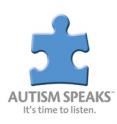Study finds pregnancy and birth environment may affect development of autism in twins
Autism Speaks, the world's largest autism science and advocacy organization, joined in announcing significant findings from the largest known study of twins with autism spectrum disorder (ASD). This work, conducted by a consortium of renowned researchers and using material from Autism Speaks Autism Genetic Resource Exchange (AGRE) was published online today in the Archives of General Psychiatry. The California Autism Twins Study suggests environmental influences, which could include parental age, low birth weight, multiple births, and maternal infections during pregnancy may greatly increase risk for ASD. The study suggested that both genetic and shared environmental factors significantly increase risk for ASD: an estimated 38 percent of risk being associated with genetic heritability and 58 percent with the environment that twins share during pregnancy and perhaps early infancy. The study also found that the relative contributions of shared genes and shared environment are similar for males and females.
"It has been well-established that genetic factors contribute to risk for autism," says Clara Lajonchere, Ph.D., a study co-author and vice president of clinical programs for Autism Speaks. "We now have strong evidence that, on top of genetic heritability, a shared prenatal environment may have a greater than previously realized role in the development of autism."
The study involved 192 pairs of twins, both identical and non-identical, where at least one of the twins in the pair had autism. This approach allowed the researchers to look at how often both children in the twin pair received a diagnosis of autism. Study of identical twins, who share 100 percent of their genes, helps researchers determine the degree to which a disorder is inherited, or genetic; and comparison to fraternal twins, who share around 50 percent of their DNA, allows researchers to understand how environmental influences add to the risk of ASD.
The finding that shared environment is of significant influence in twins has important implications for future research. Because the prenatal environment and early postnatal environment are shared between twins, it is believed that at least some of the environmental factors affecting susceptibility to autism exert their effect during these critical periods of life. Future studies that investigate such twin-shared experiences and their role in enhancing or suppressing genetic susceptibility are likely to advance the understanding of autism.
The study could not pinpoint the specific time period (i.e. early pregnancy, late pregnancy or birth), nor the specific risk factors (i.e. parental age, maternal nutrition, maternal infections during pregnancy, premature and/or underweight birth, etc.) that contribute to the increased risk notes Dr. Lajonchere. "Indeed, multiple-birth pregnancies are themselves associated with increased risk of developmental disorders such as cerebral palsy and autism. This speaks to the importance of further study on what prenatal and perinatal factors increase risk beyond that of inherited genes," she concludes.
AGRE, which Dr. Lajonchere heads, was instrumental in this study. AGRE clinical staff recruited twins to participate and performed the home-based testing of many of the study participants, using scientifically validated research measures for diagnosing autism spectrum disorders. Other institutes involved in the study include: Stanford University, Environmental Health Investigations Branch, California Department of Public Health, Kaiser Permanente Northern California, University of California Davis, MIND Institute, and the Institute for Human Genetics and Department of Epidemiology and Biostatistics, University of California, San Francisco
Source: Autism Speaks
Articles on the same topic
- Balance tips toward environment as heritability ebbs in autism? Mon, 4 Jul 2011, 21:02:08 UTC
- Study of twins suggests genetic component of autism spectrum disorders may be moderateMon, 4 Jul 2011, 21:01:59 UTC
Other sources
- Environment blamed for autismfrom Sciencenews.orgFri, 8 Jul 2011, 0:31:56 UTC
- Environment blamed for autismfrom Sciencenews.orgThu, 7 Jul 2011, 21:31:06 UTC
- Balance tips toward environment as heritability ebbs in autism? Non-inherited genetic factors also in the mix, study findsfrom Science DailyMon, 4 Jul 2011, 23:30:32 UTC
- Genetic component of autism spectrum disorders may be moderate, study of twins suggests; Environmental component may be substantialfrom Science DailyMon, 4 Jul 2011, 23:30:30 UTC
- Pregnancy and birth environment may affect development of autism in twins, study findsfrom Science DailyMon, 4 Jul 2011, 23:30:24 UTC
- Autism study downplays role of geneticsfrom LA Times - ScienceMon, 4 Jul 2011, 22:30:19 UTC
- Autism study downplays role of geneticsfrom LA Times - HealthMon, 4 Jul 2011, 22:00:35 UTC
- Fraternal twins with autism: Is risk in the womb?from AP HealthMon, 4 Jul 2011, 21:00:33 UTC
- New Study Implicates Environmental Factors in Autismfrom NY Times HealthMon, 4 Jul 2011, 21:00:16 UTC
- Autism risk turns to womb in fraternal twin studyfrom CBC: HealthMon, 4 Jul 2011, 20:30:50 UTC
- Balance tips toward environment as heritability ebbs in autism?from PhysorgMon, 4 Jul 2011, 20:00:29 UTC
